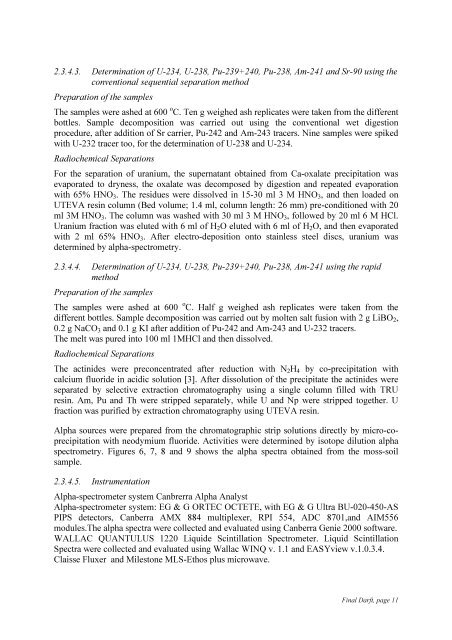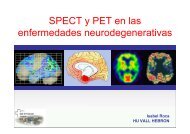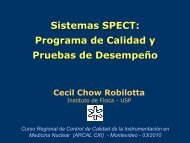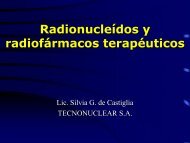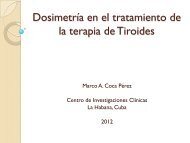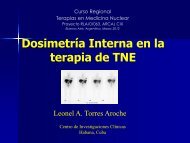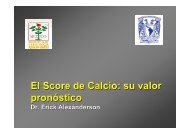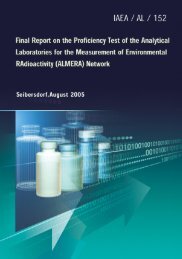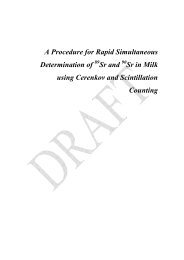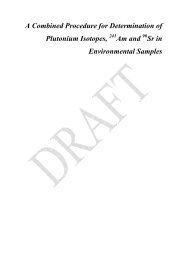Worldwide Open Proficiency Test: Determination of ... - Nucleus - IAEA
Worldwide Open Proficiency Test: Determination of ... - Nucleus - IAEA
Worldwide Open Proficiency Test: Determination of ... - Nucleus - IAEA
You also want an ePaper? Increase the reach of your titles
YUMPU automatically turns print PDFs into web optimized ePapers that Google loves.
2.3.4.3. <strong>Determination</strong> <strong>of</strong> U-234, U-238, Pu-239+240, Pu-238, Am-241 and Sr-90 using the<br />
conventional sequential separation method<br />
Preparation <strong>of</strong> the samples<br />
The samples were ashed at 600 o C. Ten g weighed ash replicates were taken from the different<br />
bottles. Sample decomposition was carried out using the conventional wet digestion<br />
procedure, after addition <strong>of</strong> Sr carrier, Pu-242 and Am-243 tracers. Nine samples were spiked<br />
with U-232 tracer too, for the determination <strong>of</strong> U-238 and U-234.<br />
Radiochemical Separations<br />
For the separation <strong>of</strong> uranium, the supernatant obtained from Ca-oxalate precipitation was<br />
evaporated to dryness, the oxalate was decomposed by digestion and repeated evaporation<br />
with 65% HNO3. The residues were dissolved in 15-30 ml 3 M HNO3, and then loaded on<br />
UTEVA resin column (Bed volume; 1.4 ml, column length: 26 mm) pre-conditioned with 20<br />
ml 3M HNO3. The column was washed with 30 ml 3 M HNO3, followed by 20 ml 6 M HCl.<br />
Uranium fraction was eluted with 6 ml <strong>of</strong> H2O eluted with 6 ml <strong>of</strong> H2O, and then evaporated<br />
with 2 ml 65% HNO3. After electro-deposition onto stainless steel discs, uranium was<br />
determined by alpha-spectrometry.<br />
2.3.4.4. <strong>Determination</strong> <strong>of</strong> U-234, U-238, Pu-239+240, Pu-238, Am-241 using the rapid<br />
method<br />
Preparation <strong>of</strong> the samples<br />
The samples were ashed at 600 o C. Half g weighed ash replicates were taken from the<br />
different bottles. Sample decomposition was carried out by molten salt fusion with 2 g LiBO2,<br />
0.2 g NaCO3 and 0.1 g KI after addition <strong>of</strong> Pu-242 and Am-243 and U-232 tracers.<br />
The melt was pured into 100 ml 1MHCl and then dissolved.<br />
Radiochemical Separations<br />
The actinides were preconcentrated after reduction with N2H4 by co-precipitation with<br />
calcium fluoride in acidic solution [3]. After dissolution <strong>of</strong> the precipitate the actinides were<br />
separated by selective extraction chromatography using a single column filled with TRU<br />
resin. Am, Pu and Th were stripped separately, while U and Np were stripped together. U<br />
fraction was purified by extraction chromatography using UTEVA resin.<br />
Alpha sources were prepared from the chromatographic strip solutions directly by micro-coprecipitation<br />
with neodymium fluoride. Activities were determined by isotope dilution alpha<br />
spectrometry. Figures 6, 7, 8 and 9 shows the alpha spectra obtained from the moss-soil<br />
sample.<br />
2.3.4.5. Instrumentation<br />
Alpha-spectrometer system Canbrerra Alpha Analyst<br />
Alpha-spectrometer system: EG & G ORTEC OCTETE, with EG & G Ultra BU-020-450-AS<br />
PIPS detectors, Canberra AMX 884 multiplexer, RPI 554, ADC 8701,and AIM556<br />
modules.The alpha spectra were collected and evaluated using Canberra Genie 2000 s<strong>of</strong>tware.<br />
WALLAC QUANTULUS 1220 Liquide Scintillation Spectrometer. Liquid Scintillation<br />
Spectra were collected and evaluated using Wallac WINQ v. 1.1 and EASYview v.1.0.3.4.<br />
Claisse Fluxer and Milestone MLS-Ethos plus microwave.<br />
Final Darft, page 11


